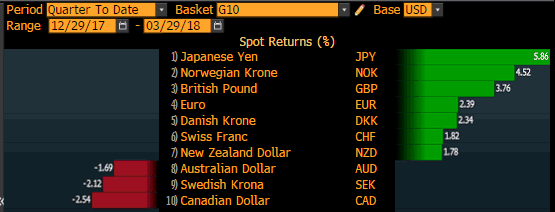The first quarter of 2018 has officially drawn to a close and there have been some big swings in currencies over the last 3 months. The best performer was the Japanese Yen, which soared against all of the major currencies, gaining over 5% in value versus the U.S. dollar. However its strength was most pronounced versus the Australian and Canadian dollars where a 7% move took AUD/JPY and CAD/JPY to their weakest levels in more than a year. These declines began in January but accelerated in February when U.S. stocks peaked and started to move sharply lower. There were a lot of big stories in the first quarter but the one that had the greatest impact on currencies was the end of bull market. However as stocks fell, investors did not always park their money in U.S. dollars. Instead, they bought euros and sterling as uncertainty stemmed from U.S. policy. The Canadian and Australian dollars were the worst performers. The loonie was hit by NAFTA concerns and dovish comments from the Bank of Canada while the Australian dollar fell on the back of risk aversion and growing trade tensions between the U.S. and China. We saw the same unevenness in the dollar's performance March with euro and sterling outperforming commodity currencies.

Markets around the world are closed on Friday and while U.S. and Canadian markets reopen on Monday, Europe, Australia and New Zealand don't return from their Easter holiday until Tuesday. This means that barring an unexpected tweet from President Trump, it should be relatively quiet. U.S. stocks rebounded strongly on Thursdaybut the gains failed to translate into strength for any major currencies. A large part of this has to do with month and quarter end flows. The latest U.S. economic reports were mixed. Weekly jobless claims dropped to its lowest level since 1973 as personal income and spending growth met expectations. Yet manufacturing activity in the Chicago region slowed more than expected and the University of Michigan Consumer Sentiment index was revised lower. Looking ahead, the most important release on next week's calendar will be the March non-farm payrolls report.
EUR/USD sold off for the third day in a row with the latest decline taking the pair below the 20 and 50-day simple moving averages. This is significant because it opens the door for a move down to 1.22. The sell-off was triggered by softer than expected German consumer price growth. The ECB has been slow to change forward guidance and this latest report reinforced their cautiousness. With that in mind, year over year CPI growth in Germany still accelerated from 1.4% to 1.6% while the unemployment rate fell to 5.3% from 5.4%. Softer data also pressured GBP/USD lower. House prices fell -0.2% in March according to Nationwide, while mortgage approvals dropped to 63.9K from 67.1K. There were no revisions to U.K. Q1 GDP growth and no news on Brexit. GBP/USD has significant support between 1.3985 and 1.40.
Meanwhile the Canadian dollar was unfazed by weaker GDP growth. Throughout this week we've talked about the loonie's resilience and while USD/CAD jumped right after we learned that Canada's economy contracted -0.1% in January, the first drop in 5 months, the rally was short-lived. Part of this may have to do with the recovery in stocks and the rebound in oil prices but the weakest year over year growth in 11 monthsshould not be ignored. At minimum, it reinforces the Bank of Canada's caution and reduces the chance of another rate hike in the next few months. The Australian and New Zealand dollars also traded higher today - AUD benefited from an increase in job vacancies will NZD/USD traders took comfort from a sizeable increase in building permits. With that in mind, the Reserve Bank of Australia, who meets next week doesn't have any particular reason to change their neutral guidance.
Past performance is not indicative of future results. Trading forex carries a high level of risk, and may not be suitable for all investors. The high degree of leverage can work against you as well as for you. Before deciding to trade any such leveraged products you should carefully consider your investment objectives, level of experience, and risk appetite. The possibility exists that you could sustain a loss of some or all of your initial investment and therefore you should not invest money that you cannot afford to lose. You should be aware of all the risks associated with trading on margin, and seek advice from an independent financial advisor if you have any doubts.
Recommended Content
Editors’ Picks
EUR/USD edges lower toward 1.0700 post-US PCE

EUR/USD stays under modest bearish pressure but manages to hold above 1.0700 in the American session on Friday. The US Dollar (USD) gathers strength against its rivals after the stronger-than-forecast PCE inflation data, not allowing the pair to gain traction.
GBP/USD retreats to 1.2500 on renewed USD strength

GBP/USD lost its traction and turned negative on the day near 1.2500. Following the stronger-than-expected PCE inflation readings from the US, the USD stays resilient and makes it difficult for the pair to gather recovery momentum.
Gold struggles to hold above $2,350 following US inflation

Gold turned south and declined toward $2,340, erasing a large portion of its daily gains, as the USD benefited from PCE inflation data. The benchmark 10-year US yield, however, stays in negative territory and helps XAU/USD limit its losses.
Bitcoin Weekly Forecast: BTC’s next breakout could propel it to $80,000 Premium

Bitcoin’s recent price consolidation could be nearing its end as technical indicators and on-chain metrics suggest a potential upward breakout. However, this move would not be straightforward and could punish impatient investors.
Week ahead – Hawkish risk as Fed and NFP on tap, Eurozone data eyed too

Fed meets on Wednesday as US inflation stays elevated. Will Friday’s jobs report bring relief or more angst for the markets? Eurozone flash GDP and CPI numbers in focus for the Euro.